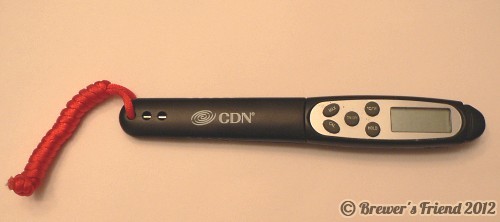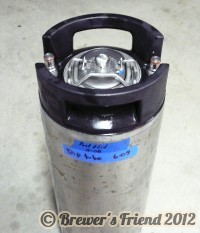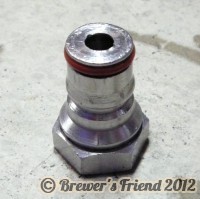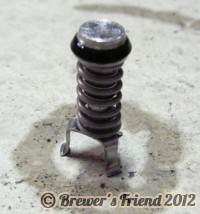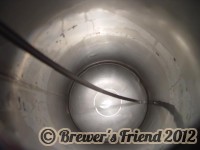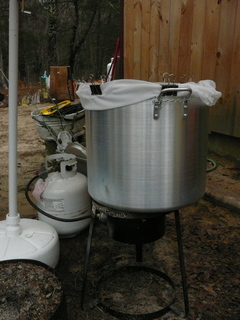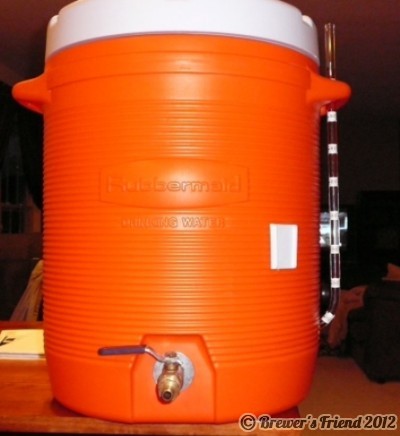Sunday, February 22nd, 2009
This article explains the basic difference between RIMS and HERMS systems. Both are advanced setups for home brewers where mash water (wort) is circulated through a heating system. The benefits include clearer wort, higher efficiency, and an impressive looking setup that helps automate the brewing process and leads to consistency.
The difference between RIMS and HERMS comes from the method of heating in order to maintain or change the mash temperature. This is very different from the basic style of mashing, where hot water is infused to raise temperature. With RIMS and HERMS heat is directly applied to the mash water.
We can begin with de-constructing the acronyms RIMS and HERMS.
RIMS is short for Recirculating Infusion Mash System.
HERMS is short for Heat Exchange Recirculating Mash System.
We also need to introduce two additional acronyms: the HLT and the MLT.
The hot liquor tank (HLT) is a kettle, or cooler full of heated water. The mash lauter tun (MLT) is where the grains are mashed, coveted to sweet wort, and lautered.
The MLT in this case is again usually a kettle or cooler, and has a false bottom to allow lautering.
A HERMS will rely on a heat exchanger, in most cases the hot liquor tank (HLT) in which a copper coil is placed, in other cases, another external vessel that is filled with a heating medium (water) in which a copper coil is immersed. The mash water is pumped through this coil, picking up heat from the surrounding water, and returned to the mash lauter tun (MLT).
A RIMS system relies on a form of direct heating where the mash water (wort) is pumped through a small tube in which an electric heating element has been installed. The mash water is pumped through this tube, past the heating element, and heated to the proper temperature prior to returning to the MLT.
Lets get more specific with the components and function of a typical HERMS. As previously stated this system is used to maintain and change the temperature of your mash, so the need for some level of automation is almost a necessity. Whether the HLT is heated with a gas burner, or with an electrical heating element, you have to control the temperature of the HLT water (heating medium) precisely in order to take full advantage of the systems ability. This control is accomplished easier when heating with electricity, where the switching (on/off) of a heating element is done via a simple temperature controller which is wired to the heating element. During operation the controller is reading the HLT water temperature via a temperature probe in the HLT water (heating medium).
To accomplish this with a gas fired HLT would require some additional equipment. This equipment would include items such as a gas solenoid valve to cut the gas to the burner when your target HLT temperature has been reached, as well as a pilot or spark ignition system to automatically re-light the burner when the temperature controller commands gas (heat) through the solenoid valve. Changing the temperature of the mash is as easy as changing the temperature setting on the temperature controller to adjust the temperature of the HLT water.
In this same system the wort is typically recirculated continuously, which is of great benefit to the all grain brewer for a couple reasons. First, you will have little or no temperature variation in your mash due to the constant draining and return of precisely heated mash water to the MLT. Second, you will have superior wort clarity since you are setting up your grain bed (filtration) during the mash while recirculating the wort. **When I say superior wort clarity, I would compare it to looking through a glass of any of the typical American Lagers that have been filtered, it is quite amazing. This recirculating of 150F-160F wort is no easy task for a simple pump, which is why most home brewers have come to rely on the March 809 pumps, which are high temperature, food grade, magnetic impeller pumps. They are a perfect fit for both HERMS and RIMS.
In brief, the RIMS is utilized to accomplish the same outcome as a HERMS, but by a slightly different means. In a RIMS you are passing the mash water directly over an electric heating element that is contained in a small tube with an inlet at one end and an outlet at the other. Controlling the temperature of a RIMS is nearly identical to the HERMS… as it is done with some type of temperature controller connected directly to the heating element. The major difference is that the temperature is measured at the OUTLET of the RIMS heating tube prior to the mash water returning to the MLT. Just as in a HERMS, the RIMS can easily change the temperature of the mash by simply adjusting the temperature on the temperature controller. A RIMS will also generally utilize a constant recirculation of the mash water via a March 809 pump, providing the same benefits to the brewer as it will in a HERMS.
The similarities in these systems are great, and the befits are many. So, why choose one over the other? Some choose the HERMS because it is more energy and equipment efficient. If you are already heating the sparge water in the HLT, why not also use this water as a heating medium? Makes perfect sense right?
Some will choose a RIMS due to the fact that they do not have to change the temperature of a large volume of water in the HLT in order to make temperature corrections, or in some cases (step mashing) large temperature changes. This makes perfect sense as well… though both systems, if used properly, can perform temperature changes, even large ones, quite effectively. The choice is yours!
Posted in Equipment | 10 Comments »




